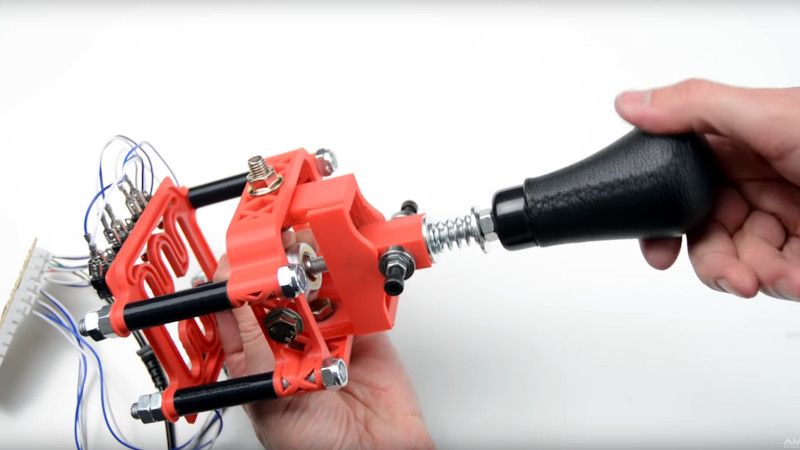If you don’t get enough driving in your real life, you can top it off with some virtual driving and even build yourself a cockpit. To this end [Noctiluxx] created a very nice 3D printable stick shifter you can build yourself.
The design is adapted for 3D printing from an older aluminium version by [Willynovi] over on the X-Simulator forums. Every version uses an off-the-shelf ball joint for the main pivot, below which is a guide plate with the desired shift pattern. Each position has a microswitch, which can be connected to a USB encoder from eBay which acts as a HID. The position is held in the Y-axis position by a clever spring-loaded cam mechanism above the ball joint, while the X-position is held by the bottom guide plate. The gear knob can be either 3D printed or the real deal of your choice.
This design is the perfect example of the power of the internet and open source. The original aluminium design is almost a decade old, but has been built and modified by a number of people over the years to get us to the easy to build version we see today. [amstudio] created an excellent video tutorial on how to built your own, see it after the break.
For more awesome cockpits check out this one to fly an actual (FPV) aircraft, and this dazzling array of 3D printable components for your own Garmin G1000 avionics glass cockpit.
















Am I missing something or is the stick not self-centering on the horizontal axis?
why would a gear shifter self center?
So it is in a known position for gear changes as indication that it is in ‘neutral’.
Because that’s what real gear shifters do, you come out of a gear, it self-centers and you know where it is without needing to wiggle it or look down.
This depends very much on the vehicle, even from the same manufacturer. Some do, some don’t, though most I have driven over the last 20 years or so do. (yes, I refer to 5 and 6 speed transmissions)
I can not speak of custom race shifter assemblies. Maybe they all self-center.
No properly working gearstick is going to not self-center. There is a defined neutral position on a common H-pattern and that’s in the middle between 3rd and 4th gear. Each and every gear stick will self-center there. One of the reasons for that is so that it’s harder to moneyshift the thing from 4th to 1st.
If it doesn’t self-center there, then the thing is just broken. Snapped return spring or heavily worn out bushings.
They self center on neutral only, you put it in gear and it stays there or you have crappy car.
You’re missing the point.
Yes it does self center. There’s a carrier in the center which has humps on it that bearings ride on top of, all of this compresses a spring which is pushing another bushing to the ball joint. When the spring is allowed to extend it pushes the bushing flush to the ball joint and self centers.
It actually works surprisingly well and is a pretty creative solution.
That’s for vertical motion, not horizontal.
I‘ve been thinking about this a bit. There is no self-centering on the left-right aka horizontal axis. To have it self-center, one would need to put the pivot point of the indented bridge higher than the ball joint. That way, when the stick is pushed to the side, the spring will be compressed, making the stick go back to center when released.
But this would cause additional wear and require a linear bearing.
Since the force for self centering is significantly less than that to keep it in gear (in my experience), it wouldn’t be hard to add some elastic below the pivot the assist with self centering without overwhelming the rest of the mechanism. Maybe add anchors to the offset pillars for rubber bands?
Apparently it does! The cup on the bottom of the ball joint acts to re-center it: https://youtu.be/KPhFCfuWimg?t=262
Almost all shifters on cars self center, if not it’s usually cause of malfunction or age.
I would have designed this more similar to a real shifter using a ball for both axis with a bushing sandwich in.
Next up!
A VW type of shifter that requires a downward push to engage reverse!
That is how the fanatec shifter works.
next next uo! a gear shifter with PRNDL and lockout park button!
fuck that.
I have that and fuck that.
Please keep your sexual preferences off of this family oriented forum.
B^)
With aggressive use what will fail first the micro style switch or to hot snot use to attach the switch to the shifter frame?. Micro switches generally don’t see such a duty cycle and are most often used to switch AC, not DC.
Micro switches are very commonly used in electronics and robotics. They make the best end stop sensors. That’s all DC.
@Danie Conradie, Awesome work! Can’t wait to try that out!
A quick mod to attach a soft bumper for each microswitch should help with durability. Nonetheless, I’d prefer going around using hot glues somehow.
Could you elaborate on the AC/DC part? Does that mean the switches are checked every so often instead of continuously?